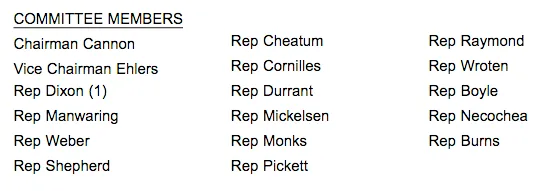The Idaho House of Representatives is comprised of 59 Republicans and 11 Democrats, meaning more than 84% of our House is Republican. The Idaho Senate has 28 Republicans and 7 Democrats, meaning our Senate is 80% Republican.
That makes a total of 87 out of 105 Republicans, making up 83% of the Legislature. Why, then, is it often so hard to pass conservative legislation?
Today was a rough day in the Capitol. Sen. Brian Lenney’s bill to preemptively ban universal basic income was killed in Senate State Affairs despite having already passed the House on a party line vote. A few minutes later, the House defeated a proposed constitutional amendment that would have preemptively banned ranked choice voting, falling five votes short of the 2/3 supermajority required to put an amendment on the ballot.

Shortly after that, the House failed to pass a memorial calling for strong border security and the impeachment of President Joe Biden for not only failing to enforce the border, but actively facilitating the invasion of our country:

24 Republicans joined with the Democrats to essentially support illegal aliens and the corporations that employ them. During committee testimony on this memorial last week, Bob Naerebout of the Idaho Dairymen’s Association admitted that 70% of his clients’ workforce was potentially illegal:
Rep. Stephanie Mickelsen was perhaps the most vociferous voice in opposition to the memorial. She took personal offense to the wording that said a desire for cheap foreign labor was driving the immigration crisis, and even objected when Rep. Josh Tanner reported that he knew of a farmer who paid workers under the table. She also repeated the old line that foreign migrants do the jobs Americans won’t do.
Democratic lawmakers such as Reps. Chris Mathias and Lauren Necochea insisted that the people crossing our border are just people fleeing poverty for a better life. On the other hand, both Reps. Joe Alfieri and Barbara Ehardt spoke the name of Laken Riley, a young woman brutally murdered by an illegal alien in Georgia recently.
Despite solid debate from Reps. Alfieri, Ehardt, Tanner, Dale Hawkins, and Dan McKnight (sitting in for Rep. Ted Hill), the memorial failed to pass the House. Big Ag won the day.
The hits didn’t stop there. Senate Bill 1234, a proposal from Democratic Sen. Melissa Wintrow to force insurers to cover up to six months of contraception per prescription rather than the three currently mandated by law, had already passed the Senate 19-16 and reached the House floor today.
Parrish Miller, who wrote the bill rating for the Idaho Freedom Index, explained the problem succinctly: “This mandate would substitute the preferences of central planners for the natural order of the market. If there were sufficient market demand for this change, it would take place without new government regulations.”
We all know that Democrats, as a rule, rarely see any problem with using the force of government to solve any perceived problem in society. Today, 24 Republicans agreed:

What is going on in our Legislature? You would think that it would not be so hard to pass conservative legislation or stop liberal bills when 83% of our lawmakers identify as Republicans. Clearly something is amiss.
The answer is fairly evident, I believe. While there are lawmakers who are ideologically conservative, and those who are ideologically progressive, there are also a great many who are ideologically moderate, or not really ideological at all. These politicians will wear whichever jersey helps them get what they want, whether it’s power for its own sake or one or two pet causes. In Democratic-led states like California or New York, they will proudly play on the Blue Team, while in Republican-led states like Idaho, they are on Team Red.
The Institute for Legislative Analysis recently examined 56 key bills from the 2023 session to see how our lawmakers self identify by virtue of their positions. While declared party affiliation in the Legislature is 87 Republicans to 18 Democrats, the revealed preferences (as expressed by actual votes) make it 52 to 53. Instead of Republicans making up 83% of the Legislature, ideological Republicans make up only 49.5%.

This puts Idaho’s Legislature closer to purple Virginia than red Florida, and explains why we continue to see conservative legislation stymied and progressive legislation make it to the governor’s desk. Idaho’s Legislature is much further to the left than Idaho’s population.
Why is that?
I think voter complacency is a big part of the problem. In most Idaho districts, voters select the Republican in the general election without worrying about his or her ideological positions. Turnout in primary elections is generally low, and whichever candidate has name recognition, the most fliers and mailers, or community support will often win. Candidates who promise to support big business, such as the corporations that make up the Idaho Association of Commerce and Industry, the Farm Bureau, or the healthcare lobbies, can count on significant campaign contributions. Candidates who oppose those special interest groups have to work harder to raise money from individuals or the handful of liberty-minded political action committees at work in our state.
It’s easy to see why this is the case. When members of IACI or the Idaho Dairymen’s Association donate to potential legislators, they expect a return on that investment. That return can be in the form of direct transfers from the taxpayer, such as the Idaho Launch Grant, or in protecting a their foreign workforce, as with the defeat of HJM 11. On the other hand, what return do contributors to the Idaho Freedom PAC or Citizen’s Alliance get for their support? Perhaps lower taxes or fewer regulation, but what they’re paying for is much more intangible: a freer Idaho for them and their children.
Tomorrow morning at 8am the House Revenue & Taxation Committee will finally hear H447, a bill establishing a tax credit for school choice. Other states such as Iowa, Texas, and Arizona have created programs to allow money to follow students, while Idaho, despite its 83% Republican Legislature, has been unable to do anything on that front. Will the committee pass a very basic and narrow school choice bill to the floor? Stay tuned.

The results we saw today, and have been seeing in the Idaho Legislature for years now, clearly show why we need more conservatives in office. We would be better off with a Legislature that’s 60% Republican, so long as they were ideologically conservative, rather than 83% that happen to be wearing red jerseys. Our status as a red state is a mirage.
All 105 legislative seats are up for election this year. It is vitally important to make an informed decision, not just in the November general election but in the May primary as well. In many cases you will have a choice between a Republican who is ideologically moderate, or not ideological at all, and a conservative Republican who will support good legislation without fear of repercussions from IACI, Big Ag, the public sector unions, or any of the other special interests that exert outsized influence in Idaho politics.
Here at Gem State Chronicle I will do my best to help you make an informed decision. I’ll soon post profiles of every single candidate for the Republican legislative primary with their background, voting record if any, endorsements, and affiliations. I want to be a resource for engaged voters this year. If we’re to preserve our liberties in the Gem State for generations to come, we need voters who are not only well informed but willing to use their time, energy, and money to elect good candidates. This is your state, and it’s up to you to save it.
Head over to Substack for a bonus note with a sneak preview! Not subscribed? Click here!
About Brian Almon
Brian Almon is the Editor of the Gem State Chronicle. He also serves as Chairman of the District 14 Republican Party and is a trustee of the Eagle Public Library Board. He lives with his wife and five children in Eagle.













One Comment
Comments are closed.